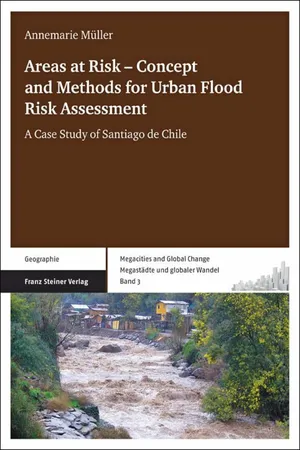
Areas at Risk – Concept and Methods for Urban Flood Risk Assessment
A Case Study of Santiago de Chile
- 269 pages
- English
- PDF
- Available on iOS & Android
Areas at Risk – Concept and Methods for Urban Flood Risk Assessment
A Case Study of Santiago de Chile
About this book
Urban expansion and associated land-use changes increase both flood hazards and exposure. This e-book provides a conceptual and methodological framework for the analysis of urban flood risk in dynamic and complex settings, and proposes a comprehensive, system-oriented, integrated approach for its assessment.
The risk assessment is carried out using case-specific indicators on the sub-city scale in two municipalities of Santiago de Chile. Relevant information is derived from various geodata sources, and together with explorative scenarios, is used to estimate future risk development. All data about hazard, elements at risk, and their vulnerability are compiled to a GIS-based risk map to join the risk-relevant components, to show their interrelations, and to provide a tool for monitoring and evaluating their changes over time. Finally, previous deficits in flood risk prevention and mitigation are outlined and recommendations on risk reduction are made.
Frequently asked questions
- Essential is ideal for learners and professionals who enjoy exploring a wide range of subjects. Access the Essential Library with 800,000+ trusted titles and best-sellers across business, personal growth, and the humanities. Includes unlimited reading time and Standard Read Aloud voice.
- Complete: Perfect for advanced learners and researchers needing full, unrestricted access. Unlock 1.4M+ books across hundreds of subjects, including academic and specialized titles. The Complete Plan also includes advanced features like Premium Read Aloud and Research Assistant.
Please note we cannot support devices running on iOS 13 and Android 7 or earlier. Learn more about using the app.
Information
Table of contents
- ACKNOWLEDGEMENTS
- CONTENT
- LIST OF FIGURES
- LIST OF TABLES
- LIST OF ABBREVIATIONS
- 1 INTRODUCTION
- 2 DISASTER RISK RELATED TERMS AND CONCEPTDEVELOPMENT
- 3 EXISTING FLOOD RISK-RELATED RESEARCH
- 4 DESCRIPTION OF THE STUDY AREA
- 5 DEFINITION OF A CASE SPECIFIC INDICATOR SET FOR THERISK ANALYSIS
- 6 DATA BASE AND DATA PROCESSING
- 7 REMOTE SENSING DATA ANALYSIS
- 8 HYDROLOGIC MODELING
- 9 FLOOD RISK ANALYSIS AND ASSESSMENT
- 10 PREVENTION AND MITIGATION MEASURES
- 11 DISCUSSION AND CONCLUSIONS
- REFERENCES
- APPENDIX 1 – ADDITIONAL TABLES AND CHARTS
- APPENDIX 2 – COLOURED FIGURES